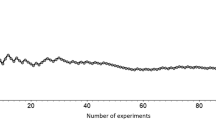Summary
The day-by-day observations made by the experimenter during one of the activity-based classes indicate that college students can learn to discover some elementary probability models and formulas for themselves while working on probability experiments in small groups. Furthermore, the effects of sample size upon measures of central tendency and variability can be learned by students working on activities such as those developed for the experimental course in this study. Making guesses for the probability of events and checking guesses with a hand-held calculator seems to help college students to be more cautious about probability estimates, and helps to make them aware about some of their own misconceptions about probability. Small-group problem solving, keeping a log of all class work and activities, and investigating the misuses of statistics all appeared to have a positive effect upon college students' attitudes towards mathematics, as indicated in the questionnaires filled out by the subjects in the experimental sections.
The present results of this study support the hypotheses of Kahneman and Tversky [10, 12] which claimed that combinatorially naive college students rely upon availability and representativeness to estimate the likelihood of events. Kahneman and Tversky were skeptical about the possibility of helping students to overcome their reliance upon availability and representativeness. The results on the posttest in this study suggest that the manner in which college students learn probability makes a difference in their ability to overcome misconceptions that arise from availability and representativeness. Mere exposure to probability concepts is not sufficient to overcome certain misconceptions of probability. Fischbein [9] notes that the “synthesis between the necessary and the possible-which is the basis of probabilistic thinking-does not in fact take place spontaneously ....” He claims that science education emphasizes only the deterministic aspect, and neglects the study of uncertainty. Thus peoples' intuition of probabilistic thinking is distorted by science education's emphasis on the necessary, and neglect of the possible. This experiment suggests that the course methodology and the teaching model used in an elementary probability course can help develop peoples' intuition for probabilistic thinking. A course in which students carry out experiments, work through activities to build their own probability models, and discover counting principles for themselves can help students to overcome their misconceptions about probability, and can help restore the synthesis between the necessary and the possible which is essential to probabilistic thinking.
Similar content being viewed by others
Bibliography
Tversky, A. and Kahneman, D., ‘Belief in the Law of Small Numbers’, Psychological Bulletin 76 (1971), 105–110.
Shaughnessy, J. M., ‘A Clinical Investigation of College Students’ Reliance Upon the Heuristics of Availability and Representativeness in Estimating the Likelihood of Probabilistic Events’, Unpublished Doctoral Dissertation, (1976).
Cohen, J., ‘Subjective Probability’, Scientific American 197 (1957), 129–138.
Cohen, J., Chance, Skill, and Luck: The Psychology of Guessing and Gambling, Baltimore, Penguin Books, 1960.
Cohen, J. and Hansel, M., Risk and Gambling, New York, Philosophical Libraries Incorporated, 1956.
Edwards, W., ‘Conservatism in Human Information Processing’, in B., Kleinmutz (ed.), Formal Representations of Human Judgment, New York, Wiley, 1968.
Fischbein, E., Bărbat, I., and Mînzat, I., ‘Intuitions primaires et intuitions second-aires dans l'initiation aux probabilités’, Educational Studies in Mathematics 4 (1971), 264–280.
Fischbein, E., The Intuitive Sources of Probabilistic Thinking In Children, Dordrect-Boston, D. Reidel, 1975.
Fischbein, E., ‘Probabilistic Thinking in Children and Adolescents’, in R. Bechauf (ed.), Forschung zum Prozess des Mathematiklernens, Institut für Didaktik der Mathematik der Universität Bielefeld, 1976, 23–42.
Kahneman, D. and Tversky, A., “Subjective Probability: A Judgment of Representativeness’, Cognitive Psychology 3 (1972), 430–454.
Kahneman, D. and Tversky, A., ‘On the Psychology of Prediction’, Psychological Review 80 (1973), 237–251.
Kahneman, D. and Tversky, A., ‘Availability: A Heuristic for Judgeing Frequency and Probability’, Cognitive Psychology 5 (1973), 207–232.
Kahneman, D. and Tversky, A., ‘Judgement Under Uncertainty: Heuristics and Biases’ Science 185 (1974), 1124–1131.
Carnap, R., ‘What is Probability’, Scientific American 189 (1953), 128–138.
Mosteller, F., Kruskal, W. H., Link, R. F., Peiters, R. S., and Rising, G. R., Statistics By Example, Reading, Addison-Wesley, 1973.
Mosteller, F., Fifty Challenging Problems in Probability With Solutions, Reading, Addison-Wesley, 1962.
Huff, D., How to Lie with Statistics, London, W. W. Norton, 1954.
Weiss, N. A., and Yoseloff, M. L., Finite Mathematics, New York, Worth, 1975.
Pollak, H., ‘On Some Problems of Teaching Applications of Mathematics’, Educational Studies in Mathematics 1 (1968), 24–30.
Thompson, M., ‘Models, Problems and Applications of Mathematics’, Unpublished Pre-conference paper for a Conference on Topical Resource Books for Mathematics Teachers, Eugene Oregon, 1974.
Klamkin, M., ‘On the Teaching of Mathematics so at to be Useful’, Educational Studies in Mathematics 1 (1968), 126–160.
Fitzgerald, W., ‘The Role of Mathematics in a Comprehensive Problem Solving Curriculum in Secondary Schools’, School Science and Mathematics (1975), 39–47.
Freudenthal, H., ‘Why to Teach Mathematics so as to be Useful’, Educational Studies in Mathematics 1 (1968), 3–8.
Author information
Authors and Affiliations
Rights and permissions
About this article
Cite this article
Shaughnessy, J.M. Misconceptions of probability: An experiment with a small-group, activity-based, model building approach to introductory probability at the college level. Educ Stud Math 8, 295–316 (1977). https://doi.org/10.1007/BF00385927
Issue Date:
DOI: https://doi.org/10.1007/BF00385927




